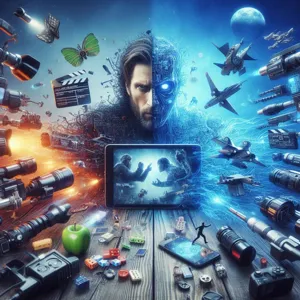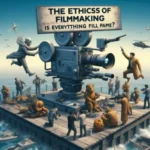In the ever-evolving landscape of cinema, technology has emerged as both a powerful ally and a contentious adversary.
From the early days of silent films to today’s digital masterpieces, technological advancements have continually reshaped the way stories are told on screen. But as filmmakers increasingly rely on cutting-edge tools—be it CGI, drones, virtual reality, or sophisticated editing software—a pressing question arises: is technology an innovation that enhances the art of filmmaking, or is it an intrusion that risks overshadowing the human touch in storytelling? In this blog post, we will explore the profound impact of technology on the filmmaking process, examining how it has transformed everything from pre-production planning to post-production polishing. We’ll delve into the benefits and potential pitfalls of modern filmmaking techniques, showcasing how they can elevate a film’s narrative while also challenging traditional craftsmanship. Join us as we navigate this complex relationship between art and technology, uncovering the true essence of creativity in the digital age.
1. Introduction: The Intersection of Technology and Filmmaking

In the realm of filmmaking, the convergence of technology and artistic vision has sparked a transformative revolution, reshaping the way stories are told and experienced. From the advent of sound in the early 20th century to the stunning visuals of today’s CGI and virtual reality, technology has continuously pushed the boundaries of creativity. But as we stand at this intersection of innovation, a pressing question emerges: is technology enhancing the filmmaking process, or is it intruding upon the very essence of art?
Filmmakers now wield a plethora of tools that empower them to craft intricate narratives and push the limits of imagination. Digital cameras with astonishing resolutions, editing software that allows for seamless post-production, and advanced sound design techniques provide filmmakers with unprecedented opportunities to bring their visions to life. However, this abundance of technological resources can also lead to an over-reliance on gadgets and gizmos, potentially overshadowing the fundamental qualities of storytelling and human emotion.
As we delve into the diverse perspectives surrounding this topic, we will explore how technology serves as both a powerful ally and a potential detractor in the filmmaking process. By examining the impacts of innovations such as artificial intelligence, streaming platforms, and immersive experiences, we aim to uncover whether these advancements enhance or diminish the art of filmmaking. Join us on this journey as we navigate the complexities of technology’s role in shaping the cinematic landscape, seeking to understand whether it is fostering a new era of creativity or creating barriers to authentic storytelling.
2. Historical Evolution of Filmmaking Technology
The history of filmmaking technology is a fascinating journey that reflects the evolution of not only the medium itself but also the artistic vision and storytelling capabilities of filmmakers throughout the ages. From the early flickers of light produced by the magic lantern in the 17th century to today’s sophisticated CGI and virtual reality experiences, each technological advancement has significantly shaped the way stories are told on screen.
In the late 19th century, the invention of the motion picture camera marked a revolutionary leap forward. Pioneers like Thomas Edison and the Lumière brothers harnessed the power of film to capture life’s moments, forever changing the landscape of entertainment. The introduction of celluloid film in the 1880s provided filmmakers with a medium that was both affordable and versatile, leading to the birth of narrative cinema.
As we moved into the 20th century, the silent film era paved the way for sound technology, transforming the audience’s experience. The 1927 release of “The Jazz Singer,” the first synchronized sound feature, marked a pivotal moment in cinematic history. This innovation not only enhanced storytelling but also pushed filmmakers to explore sound design and music as integral parts of their narratives.
The evolution didn’t stop there. The introduction of color film in the 1930s was another game changer, allowing filmmakers to infuse their work with vibrant hues that added emotional depth and visual appeal. The leap from Technicolor to digital projection in the late 20th century altered the industry once again, making film production more accessible and leading to a democratization of creativity.
In recent decades, advancements in digital technology have revolutionized filmmaking yet again. High-definition cameras, drones for aerial shots, and editing software that once required a professional studio can now be utilized by aspiring filmmakers from the comfort of their own homes. These tools not only streamline the production process but also allow for greater experimentation and innovation.
However, with these advancements come debates about the authenticity of the filmmaking process. As technology becomes more integrated into the craft, some purists argue that it detracts from the artistry, reducing the tactile experience of traditional filmmaking. Others embrace it as a means to expand creative boundaries and reach wider audiences.
The historical evolution of filmmaking technology serves as a testament to the relentless pursuit of innovation within the industry. As we stand on the brink of new technological frontiers, such as artificial intelligence and immersive experiences, the conversation surrounding technology’s role in filmmaking—whether as an innovation or an intrusion—continues to unfold, shaping the art of storytelling for generations to come.
3. Key Technological Innovations that Transformed Filmmaking

The landscape of filmmaking has been dramatically reshaped by a series of key technological innovations that have not only enhanced creativity but also transformed the very fabric of storytelling. From the early days of silent films to the current era of digital cinema, these advancements have opened new avenues for filmmakers, allowing them to explore, experiment, and engage audiences in ways previously unimaginable.
One of the most significant innovations is the advent of digital cinematography. The transition from traditional film to digital formats has revolutionized the way movies are shot and produced. Digital cameras offer filmmakers unprecedented flexibility, enabling them to shoot in a variety of conditions with high-quality results. This shift has not only reduced production costs but has also democratized filmmaking, allowing indie filmmakers access to tools once reserved for major studios.
Another groundbreaking development is the rise of computer-generated imagery (CGI). This technology has expanded the boundaries of visual storytelling, making it possible to create fantastical worlds and characters that would be impossible to achieve with practical effects alone. Iconic films such as “Avatar” and “The Lord of the Rings” showcase the power of CGI, transporting audiences to breathtaking realms that captivate the imagination.
Moreover, advancements in editing software have transformed the post-production process. Tools like Adobe Premiere Pro and Final Cut Pro enable editors to manipulate footage with incredible precision, allowing for seamless transitions and creative effects. This democratization of editing technology means that even novice filmmakers can produce professional-quality work from the comfort of their own homes.
Virtual reality (VR) and augmented reality (AR) are also making waves in the industry, offering immersive experiences that engage viewers on a whole new level. Filmmakers are experimenting with these technologies to create interactive narratives that allow audiences to step into the story, effectively blurring the lines between creator and viewer.
Finally, streaming platforms have redefined distribution and accessibility in filmmaking. With services like Netflix, Hulu, and Amazon Prime Video, films can reach global audiences instantly, breaking down geographic barriers and changing the way films are marketed and consumed. This shift has not only provided filmmakers with new revenue streams but has also encouraged a diverse range of storytelling that caters to varied tastes and preferences.
In summary, the key technological innovations in filmmaking have ushered in a new era of creativity and accessibility. While some may argue that these advancements can lead to a reliance on technology over artistry, the truth is that they offer filmmakers powerful tools to enhance their craft and engage audiences in innovative ways. As technology continues to evolve, the possibilities for storytelling in film are boundless, challenging filmmakers to push the boundaries of their imagination.
4. The Impact of Digital Cameras on Cinematography
The advent of digital cameras has fundamentally transformed the landscape of cinematography, ushering in a new era of filmmaking that is both innovative and, at times, contentious. Gone are the days when filmmakers relied heavily on cumbersome film stock, which not only dictated the technical limitations of their craft but also imposed significant financial constraints. With the introduction of digital cameras, filmmakers now have unprecedented access to a range of creative possibilities, enabling them to experiment with shots and styles previously deemed impractical or too costly.
Digital cameras offer a remarkable level of flexibility and immediacy. Filmmakers can review their takes on the spot, adjusting lighting, framing, and performance in real time. This instant feedback loop allows for a more collaborative environment on set, as directors and cinematographers can make informed decisions without the lengthy wait associated with film processing. Additionally, the lower cost of shooting with digital means that independent filmmakers can produce high-quality content without the financial backing of major studios, democratizing the industry and leading to a more diverse array of voices and stories.
However, this technological shift is not without its drawbacks. The ease of shooting with digital cameras can sometimes lead to a more casual approach to cinematography, as the perceived abundance of storage and the ability to shoot endlessly might encourage filmmakers to prioritize quantity over quality. The artistry of framing, lighting, and composition can occasionally suffer as a result, leading to a reliance on digital effects and corrections in post-production instead of meticulous planning on set.
Moreover, the rapid evolution of digital technology can create a sense of anxiety among cinematographers. With new models and advancements rolling out at a breakneck speed, there’s an ongoing pressure to stay current and adapt to the latest tools and trends. This can lead to a feeling of intrusion, where the technology itself dictates creative choices rather than serving as a facilitator of artistic expression.
Ultimately, the impact of digital cameras on cinematography is a double-edged sword. They have unlocked a world of possibilities for filmmakers, empowering them to push boundaries and explore new narrative forms. However, the challenge lies in balancing the advantages of this technology with a commitment to the core principles of cinematic artistry. As the industry continues to evolve, it remains crucial for filmmakers to leverage these tools thoughtfully, ensuring that innovation enhances rather than intrudes upon the storytelling process.
5. Editing Software: Streamlining the Post-Production Process

Editing software has revolutionized the post-production process, transforming it from a time-consuming, labor-intensive task into a streamlined, efficient workflow that enhances creativity and precision. Gone are the days of physically cutting film strips and painstakingly splicing them together; today’s digital editing platforms allow filmmakers to manipulate footage with remarkable speed and ease.
Modern editing software, such as Adobe Premiere Pro, Final Cut Pro, and DaVinci Resolve, offers an array of powerful tools that cater to both novice and professional filmmakers. These programs provide intuitive interfaces, enabling users to cut, trim, and arrange clips with just a few clicks. Advanced features like multi-camera editing, color grading, and audio mixing allow for a level of control and creativity that was previously unimaginable. Filmmakers can experiment with different sequences, visualize their stories in real-time, and even collaborate with team members across the globe through cloud-based editing solutions.
However, with this wealth of technology comes a double-edged sword. While editing software undoubtedly streamlines the process, it can also lead to an over-reliance on digital effects and shortcuts that may overshadow the storytelling aspect of filmmaking. The infinite possibilities can sometimes overwhelm creators, tempting them to prioritize flashy edits over narrative substance. Therefore, it’s essential for filmmakers to strike a balance between embracing technological advancements and maintaining the core principles of storytelling that engage audiences.
In the end, editing software serves as a powerful ally in the pursuit of cinematic excellence. By leveraging these tools effectively, filmmakers can enhance their vision, create compelling narratives, and ultimately, deliver a polished final product that resonates with viewers. The challenge lies not in the technology itself, but in ensuring that it supports the art of filmmaking rather than detracts from it.
6. Special Effects: Enhancements vs. Authenticity
In the ever-evolving landscape of filmmaking, special effects serve as a double-edged sword, offering both enhancements to storytelling and challenges to authenticity. The advancements in technology have given filmmakers unprecedented tools to create visually stunning worlds, breathtaking action sequences, and fantastical creatures that were once limited to the realms of imagination. From CGI landscapes that transport audiences to distant galaxies to meticulously crafted practical effects that ground a film in reality, the debate continues: Are these innovations enhancing the art of storytelling, or are they detracting from the raw, authentic experience that cinema can deliver?
On one hand, special effects can elevate a film, allowing creators to realize their visions in ways that were previously unattainable. Iconic films like “Avatar” and “The Lord of the Rings” have pushed the boundaries of visual storytelling, immersing viewers in elaborate universes where the impossible becomes possible. These effects can provoke awe and wonder, drawing audiences deeper into the narrative and connecting them emotionally to the characters and their journeys.
However, with the rise of digital manipulation comes the risk of overshadowing the core essence of filmmaking: storytelling. The over-reliance on special effects can lead to a disconnect between the viewer and the characters, as audiences may find themselves more focused on the spectacle than the emotional arcs that drive the narrative. This can lead to a perception of films as mere showcases of technology rather than genuine artistic endeavors. Films that heavily depend on CGI can sometimes feel sterile, lacking the visceral quality that practical effects or authentic performances can provide.
Ultimately, the challenge lies in striking a delicate balance. Filmmakers must consider how special effects serve their story and whether they enhance or detract from the emotional experience they wish to convey. The key is to use technology as a tool to enrich the narrative rather than overshadow it. When special effects are thoughtfully integrated and aligned with the film’s tone and message, they can result in a breathtaking cinematic experience that resonates with audiences long after the credits roll.
7. The Role of Streaming Services and Digital Distribution

In recent years, streaming services and digital distribution have revolutionized the landscape of filmmaking, blurring the lines between traditional cinema and at-home viewing experiences. Platforms like Netflix, Amazon Prime, Hulu, and Disney+ have emerged as powerhouses, not only providing audiences with unprecedented access to a vast array of content but also reshaping how films are produced, marketed, and consumed.
These services have democratized film distribution, enabling independent filmmakers to reach global audiences without the need for conventional studio backing. No longer constrained by theatrical release windows, creators can now release their films directly to streaming platforms, often bypassing the traditional gatekeepers of the industry. This shift has given rise to a more diverse range of voices and stories, allowing niche genres and underrepresented perspectives to find their audiences.
Moreover, the data-driven nature of streaming platforms allows filmmakers and studios to gain insights into viewer preferences and behaviors. This information can inform everything from script development to targeted marketing campaigns, ensuring that content resonates with specific demographics. However, this reliance on data also poses challenges, as it can lead to formulaic storytelling driven by algorithms rather than creativity.
On the consumer side, streaming services have fundamentally changed viewing habits. Audiences now expect instant accessibility to films and series at their fingertips, leading to the rise of binge-watching culture. The convenience of digital distribution has made it easier than ever for viewers to discover new content, but it has also contributed to a saturation of choices, often overwhelming audiences with too many options.
While many celebrate the innovative potential of streaming services to elevate diverse storytelling, others express concerns about the possible intrusion of technology into the artistic process. The ease of digital distribution may encourage a focus on quantity over quality, and the algorithms that drive content recommendations can inadvertently narrow the scope of what gets made.
Ultimately, the role of streaming services and digital distribution in filmmaking is a double-edged sword. They offer exciting opportunities for innovation and accessibility but also raise important questions about the future of film as an art form in a rapidly changing digital landscape. As audiences continue to navigate this new terrain, filmmakers must find a balance between leveraging technological advancements and preserving the soul of storytelling that makes cinema so compelling.
8. Crowdsourcing and Online Funding Platforms
In the ever-evolving landscape of filmmaking, crowdsourcing and online funding platforms have emerged as pivotal tools that democratize the creative process. Gone are the days when filmmakers were solely reliant on traditional studios and investors to bring their visions to life. Today, filmmakers can tap into the power of the crowd, harnessing the enthusiasm and financial support of individuals who share their passion for storytelling.
Platforms like Kickstarter, Indiegogo, and GoFundMe have transformed how projects are financed, allowing creators to present their ideas directly to potential backers. This shift not only broadens the scope of what can be made but also fosters a sense of community and shared investment in the creative process. Filmmakers can now showcase trailers, behind-the-scenes content, or even comprehensive pitches to engage their audience effectively, creating a buzz before the cameras even roll.
However, while crowdsourcing presents a unique opportunity for filmmakers to gain financial backing, it also raises questions about the nature of artistic integrity and audience influence. When projects are funded by public contributions, there is an inherent pressure to cater to the desires of the backers, which can lead to compromises in the original vision. On the flip side, this model encourages filmmakers to be more transparent and accountable to their audience, cultivating a loyal fanbase that feels a personal connection to the project.
Moreover, the rise of online funding platforms has introduced a new layer of accessibility to filmmaking. Independent filmmakers, who may have previously struggled to secure funding, can now reach a global audience eager to support innovative and diverse voices. This shift not only enriches the film landscape by allowing underrepresented stories to emerge but also challenges the status quo of traditional filmmaking hierarchies.
In conclusion, while crowdsourcing and online funding platforms present both opportunities and challenges, they undeniably play a vital role in shaping the future of filmmaking. They encourage innovation, foster community engagement, and provide a platform for diverse narratives, ultimately redefining what it means to create and consume film in the digital age. As filmmakers navigate this new terrain, it will be intriguing to see how they balance the excitement of collective support with the need to maintain their artistic vision.
9. Technology in Film Marketing and Audience Engagement
In today’s fast-paced digital landscape, technology plays a pivotal role in the marketing of films and in engaging audiences like never before. The traditional methods of promoting a film—such as posters, trailers, and press releases—have evolved, giving way to a multifaceted approach that harnesses the power of social media, mobile apps, and interactive content.
Social media platforms like Instagram, Twitter, and TikTok have become essential tools for filmmakers and studios, allowing them to reach potential audiences directly and organically. Through strategic campaigns, filmmakers can share behind-the-scenes content, teasers, and interactive polls that not only generate buzz but also foster a sense of community among fans. For instance, viral challenges or hashtag campaigns can create a ripple effect, encouraging viewers to participate and share their excitement, effectively turning them into brand ambassadors.
Moreover, technology facilitates immersive experiences that enhance audience engagement. Virtual reality (VR) and augmented reality (AR) are breaking new ground in film promotion by allowing audiences to step into the world of the film. Imagine being able to explore a film’s setting or interact with characters through a VR experience before the film even hits theaters. This not only captivates the audience but also builds an emotional connection to the story and its characters.
Email marketing has also taken on a new dimension, leveraging data analytics to send personalized content to subscribers. By analyzing viewers’ preferences and behaviors, studios can tailor their messaging to resonate with specific segments of their audience. This targeted approach increases the likelihood of engagement, ensuring that fans receive content they are genuinely interested in.
Additionally, data-driven insights are revolutionizing the way films are marketed. By analyzing trends, audience demographics, and social media interactions, filmmakers can refine their marketing strategies in real time. This allows for more effective allocation of resources to campaigns that show promise, maximizing return on investment.
As technology continues to advance, the question remains: is it an innovation or an intrusion? While some may argue that technology detracts from the traditional artistry of filmmaking, it’s clear that when used thoughtfully, it enhances storytelling and creates deeper connections between films and their audiences. Ultimately, the successful integration of technology in film marketing is about striking the right balance—leveraging its capabilities to engage audiences while preserving the essence of the storytelling experience.
10. The Debate: Does Technology Compromise Artistic Vision?
The intersection of technology and artistry in filmmaking often sparks a heated debate: does the relentless march of technological advancement compromise the artistic vision of filmmakers, or does it enhance their creativity and storytelling potential? This question is not merely academic; it strikes at the heart of what it means to create meaningful cinema.
On one side of the argument, proponents of technology argue that innovations such as high-definition cameras, advanced editing software, and immersive sound design offer filmmakers tools that can elevate their craft to unparalleled heights. These advancements allow for unprecedented creative expression, enabling directors to bring their visions to life with clarity and precision that was once unimaginable. For instance, the use of CGI has transformed how stories are told, allowing filmmakers to create entire worlds and characters that transcend the limitations of physical sets. Films like “Avatar” and “The Lord of the Rings” showcase how technology can push the boundaries of imagination, creating visually stunning experiences that captivate audiences on a grand scale.
However, critics caution against an over-reliance on technology, arguing that it can often blur the lines between artistry and mere spectacle. The availability of sophisticated tools can lead to a phenomenon known as “technological determinism,” where the technology itself dictates the narrative and style, rather than the filmmaker’s original vision. Some filmmakers lament that the ease of digital editing can foster a reliance on flashy effects and rapid cuts, potentially sacrificing the depth and nuance of storytelling. Iconic directors like Martin Scorsese have voiced concerns that the emphasis on technology might detract from the emotional and narrative core of cinema, leading to a homogenization of films that prioritize visual impact over meaningful content.
This debate is further fueled by the rise of streaming platforms and the democratization of filmmaking tools. With more creators able to produce content at home, the landscape of filmmaking has expanded, leading to a surge of diverse voices and stories. Yet, this accessibility also raises questions about quality control and the potential dilution of artistic integrity. As technology makes filmmaking more achievable, it challenges traditional definitions of what constitutes a “great film” and whether artistic vision can thrive in a sea of content.
Ultimately, the question of whether technology is an innovation or an intrusion in filmmaking does not have a definitive answer. It lies in the hands of the storytellers—those who wield technology as a brush to paint their narratives. As the dialogue continues, filmmakers must navigate this complex relationship, embracing the tools at their disposal while remaining steadfast in their commitment to authenticity and artistic expression. The future of cinema will likely depend on finding a harmonious balance where technology serves as an ally, not a substitute, for the human touch that lies at the heart of great storytelling.
11. Case Studies: Successful Films That Leveraged Technology
In the ever-evolving landscape of filmmaking, technology has played a pivotal role in shaping narratives, enhancing visual storytelling, and pushing the boundaries of creativity. To understand the profound impact of technology in this realm, let’s delve into a few case studies of successful films that skillfully leveraged innovative tools and techniques to create cinematic masterpieces.
**1. “Avatar” (2009)**
James Cameron’s “Avatar” is often heralded as a groundbreaking film that forever changed the visual effects landscape. Utilizing advanced motion capture technology and 3D imaging, Cameron transported audiences to the vibrant, alien world of Pandora. The film’s intricate visual effects were made possible by new innovations that allowed for realistic performances to be captured in a digital environment. The result was a visually stunning spectacle that not only captivated audiences but also set a new standard for how technology could be harnessed in storytelling.
**2. “The Irishman” (2019)**
Martin Scorsese’s “The Irishman” took a bold leap into the future of filmmaking by employing state-of-the-art de-aging technology. This innovative approach allowed actors like Robert De Niro, Al Pacino, and Joe Pesci to portray their characters across multiple decades with remarkable authenticity. The seamless integration of this technology sparked discussions about its implications for the industry, particularly in how it may redefine the aging process in storytelling and expand the possibilities of casting.
**3. “Mad Max: Fury Road” (2015)**
George Miller’s “Mad Max: Fury Road” is a testament to the power of combining practical effects with cutting-edge technology. While the film is revered for its breathtaking stunts and high-octane action sequences, it also employed digital effects to enhance the visceral experience. The film’s extensive use of real vehicles, practical stunts, and minimal CGI resulted in a visceral authenticity that resonated with audiences, proving that technology, when used thoughtfully, can elevate the art of filmmaking without overshadowing the human element.
**4. “Black Panther” (2018)**
“Black Panther” not only broke box office records but also showcased the potential of technology in creating rich, immersive worlds. The film utilized advanced CGI to bring Wakanda to life, blending traditional African aesthetics with futuristic elements. Through innovative production design and visual effects, “Black Panther” offered audiences a culturally rich narrative that resonated on multiple levels. The film’s success demonstrated how technology can serve as a bridge between cultures, enabling filmmakers to tell diverse stories in a compelling way.
These case studies highlight that technology in filmmaking, when harnessed with creativity and intention, can lead to groundbreaking results. While some may view technology as an intrusion that threatens the artistry of film, these examples illustrate that it can also serve as an invaluable tool that enhances storytelling and expands the horizons of cinematic expression. As filmmakers continue to embrace and experiment with new technologies, the conversation about innovation versus intrusion will undoubtedly evolve, reflecting the dynamic nature of the industry itself.
12. The Future of Filmmaking: Trends to Watch
As we gaze into the crystal ball of filmmaking, it’s clear that the landscape is evolving at an unprecedented pace. Technology is not just a tool; it’s becoming an integral part of the creative process, shaping how stories are told and consumed. Here are some key trends that are set to redefine the future of filmmaking:
**1. Virtual Reality (VR) and Augmented Reality (AR):** These immersive technologies are taking storytelling to new dimensions. Filmmakers are experimenting with VR experiences that place audiences directly inside the narrative, allowing them to interact with characters and environments like never before. Meanwhile, AR is enhancing traditional viewing experiences, overlaying digital elements onto the physical world, creating a hybrid experience that captivates viewers.
**2. Artificial Intelligence (AI):** From scriptwriting to editing, AI is making waves across various stages of production. Advanced algorithms can analyze scripts for narrative effectiveness, predict audience reactions, and even assist in post-production tasks such as color correction and sound editing. While some fear that AI may replace human creativity, many filmmakers are embracing these tools as collaborators that enhance their artistic visions.
**3. Streaming Services and On-Demand Content:** The rise of platforms like Netflix, Hulu, and Disney+ has transformed how films are distributed and consumed. No longer confined to the big screen, filmmakers are now crafting content that caters to binge-watching audiences. This shift is leading to an increase in serialized storytelling, where complex narratives unfold over multiple episodes, allowing for deeper character development and more engaging plots.
**4. High-Quality Content Creation with Lower Budgets:** Advances in technology have democratized filmmaking, enabling even independent creators to produce high-quality content without breaking the bank. Affordable cameras, editing software, and distribution channels have empowered a new generation of filmmakers, resulting in a diverse array of voices and stories that may have otherwise gone unheard.
**5. Sustainability in Filmmaking:** As awareness of environmental issues grows, so does the push for sustainable practices within the film industry. Innovative solutions, such as using renewable energy on set, digital scripts to reduce paper waste, and eco-friendly materials for sets and costumes, are becoming the norm. This trend not only helps to minimize the carbon footprint of film production but also resonates with an increasingly environmentally conscious audience.
**6. Enhanced Audience Engagement through Social Media:** Filmmakers are leveraging social media platforms not just for marketing, but as a way to engage with audiences during the creative process. Behind-the-scenes content, live Q&A sessions, and interactive polls are fostering a sense of community and allowing viewers to feel more connected to the projects they love.
As the intersection of technology and creativity continues to expand, filmmakers must navigate these trends thoughtfully. The challenge lies in balancing innovation with the essence of storytelling, ensuring that technology serves as a tool for enhancement rather than an intrusion into the art. The future of filmmaking is bright, filled with possibilities that promise to enrich the cinematic experience for creators and audiences alike.
13. Balancing Innovation and Tradition in Filmmaking
In the ever-evolving landscape of filmmaking, the tension between innovation and tradition is palpable. On one hand, technological advancements unlock unprecedented creative possibilities, allowing filmmakers to tell stories in ways that were once unimaginable. High-definition cameras, virtual reality, and advanced CGI have transformed the visual language of cinema, granting directors the ability to create immersive worlds that captivate audiences like never before. The ability to shoot in diverse environments with compact equipment and edit seamlessly in the cloud has democratized filmmaking, empowering a new generation of storytellers to bring their visions to life.
However, this wave of innovation can also feel like an intrusion into the artistry of filmmaking. The essence of storytelling, rooted in tradition, faces a challenge as techniques that once defined cinema are overshadowed by flashy technology. The careful craftsmanship of cinematography, the subtle nuances of performances, and the power of practical effects risk being diluted in a world that often prioritizes spectacle over substance. Classic films remind us of the beauty found in simplicity—where the story and character development took center stage, unencumbered by the distractions of over-reliance on tech.
Striking a balance between these two worlds is crucial. Filmmakers today must navigate the delicate interplay of innovation and tradition, harnessing the benefits of modern technology while respecting the foundational principles of storytelling. This balance can lead to powerful cinematic experiences, where cutting-edge techniques enhance rather than overshadow the narrative. By embracing technology as a tool rather than a replacement for traditional methods, filmmakers can pay homage to the art form’s rich history while boldly stepping into the future. Ultimately, the role of technology in filmmaking is not merely about what is possible, but about what serves the story best, ensuring that innovation enriches the cinematic experience rather than diminishes it.
14. Conclusion: Embracing Technology While Preserving the Art of Storytelling
As we navigate the ever-evolving landscape of filmmaking, it’s clear that technology plays a dual role—both as a powerful enabler of creativity and a potential disruptor of traditional storytelling. In our exploration of the ways technology reshapes the cinematic experience, we’ve seen how innovations like virtual reality, drone cinematography, and advanced editing software can elevate narratives to new heights, offering audiences immersive experiences that were once the stuff of dreams. These tools empower filmmakers to push boundaries and experiment with visual storytelling in ways that were previously unimaginable.
However, with these advancements comes a cautious reminder of the core essence of filmmaking: storytelling. At its heart, cinema has always been about human connection, emotion, and the art of conveying complex narratives. Filmmakers must strike a delicate balance between leveraging cutting-edge technology and honoring the timeless principles of good storytelling. Technology should serve as an extension of a filmmaker’s vision, not overshadow it.
As we conclude this discussion, it’s essential to embrace the technological innovations that can enhance our craft while remaining vigilant against the pitfalls of over-reliance on gadgets and effects. Filmmakers must remember that the magic of cinema lies not just in visual spectacle but in the universal truths that resonate with audiences. By marrying technology with authentic storytelling, we can ensure that the art of filmmaking continues to thrive, captivating hearts and minds for generations to come. In this brave new world, innovation need not be an intrusion; instead, it can be a powerful ally in our quest to tell stories that matter.
In conclusion, technology plays a pivotal role in shaping the landscape of filmmaking, acting as both a catalyst for innovation and a potential source of intrusion. As we’ve explored, advancements such as digital cinematography, virtual reality, and artificial intelligence have revolutionized the creative process, enabling filmmakers to tell stories in ways previously unimaginable. However, this rapid evolution also raises important questions about authenticity, artistic integrity, and the essence of human connection in storytelling. As we move forward in this dynamic industry, it is essential for filmmakers to strike a balance between embracing technological advancements and preserving the core values of their craft. Ultimately, the choice lies in the hands of creators, and how they choose to navigate this intricate relationship will define the future of filmmaking. We invite you to share your thoughts on this topic—do you see technology as a boon or a barrier in your own creative endeavors?






